Analyzing McDonald's CSR and Business Ethics: A Comprehensive Report
VerifiedAdded on 2020/05/08
|11
|3403
|52
Report
AI Summary
This report provides a comprehensive analysis of McDonald's Corporate Social Responsibility (CSR) practices and business ethics. It examines the company's ethical environment, focusing on its commitment to product safety, employee training, workplace safety, and sustainable supply chains. The report highlights how McDonald's manages its business, including the role of various committees in addressing CSR issues. It also explores how the company protects its employees, ensures product safety, and manages waste to maintain a positive public image. Furthermore, the report discusses the importance of a strong code of conduct within a business, particularly from the perspective of management, emphasizing the need for managers to model ethical behavior. The report underscores how ethical practices contribute to the company's overall performance, employee satisfaction, and the well-being of the community. It also touches on the company's efforts to ensure food safety, provide diverse menu options, and engage in environmental care programs. The report concludes by emphasizing the importance of adherence to safety and sanitation policies, as well as the role of employees in reporting safety concerns. The document is contributed by a student and is available on Desklib, a platform offering AI-based study tools.
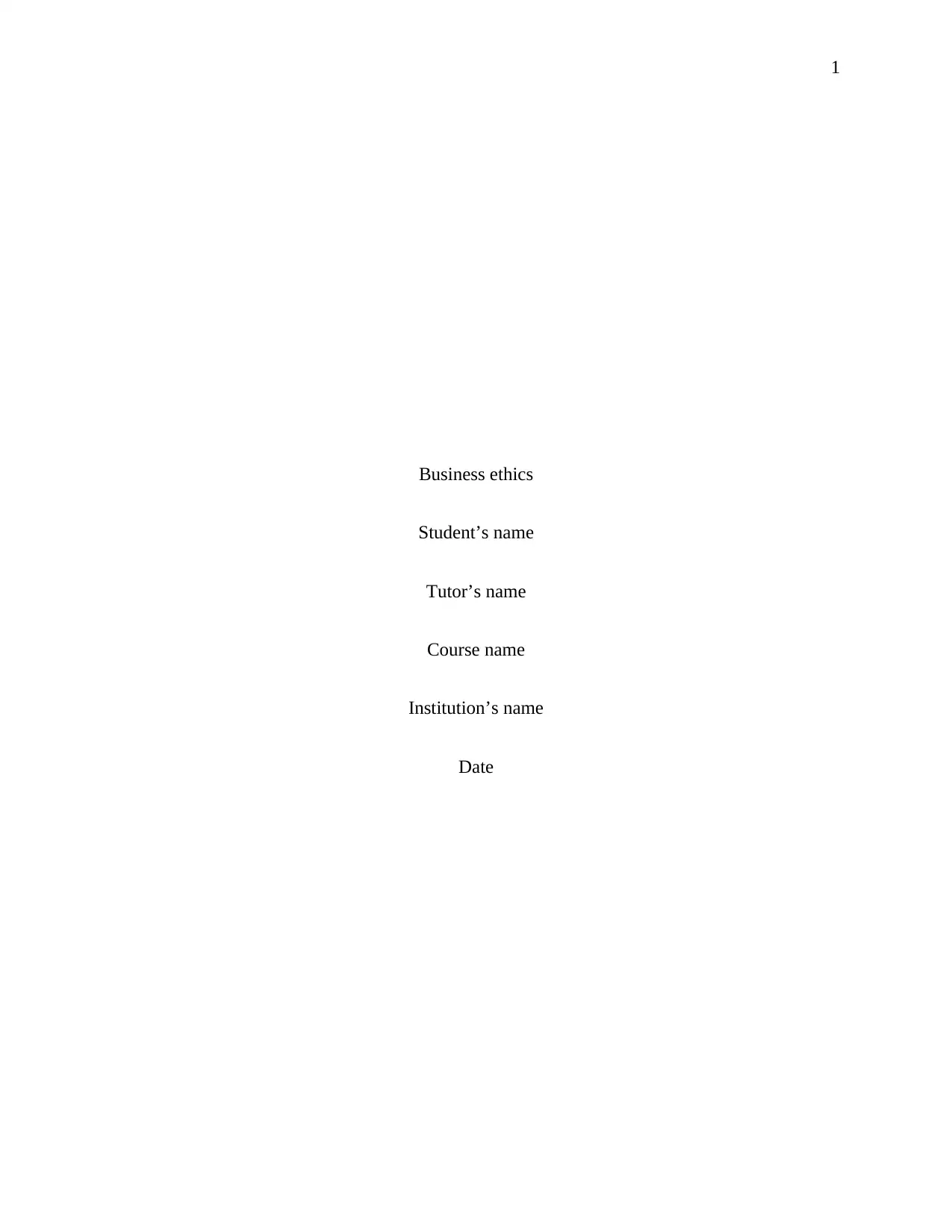
1
Business ethics
Student’s name
Tutor’s name
Course name
Institution’s name
Date
Business ethics
Student’s name
Tutor’s name
Course name
Institution’s name
Date
Paraphrase This Document
Need a fresh take? Get an instant paraphrase of this document with our AI Paraphraser
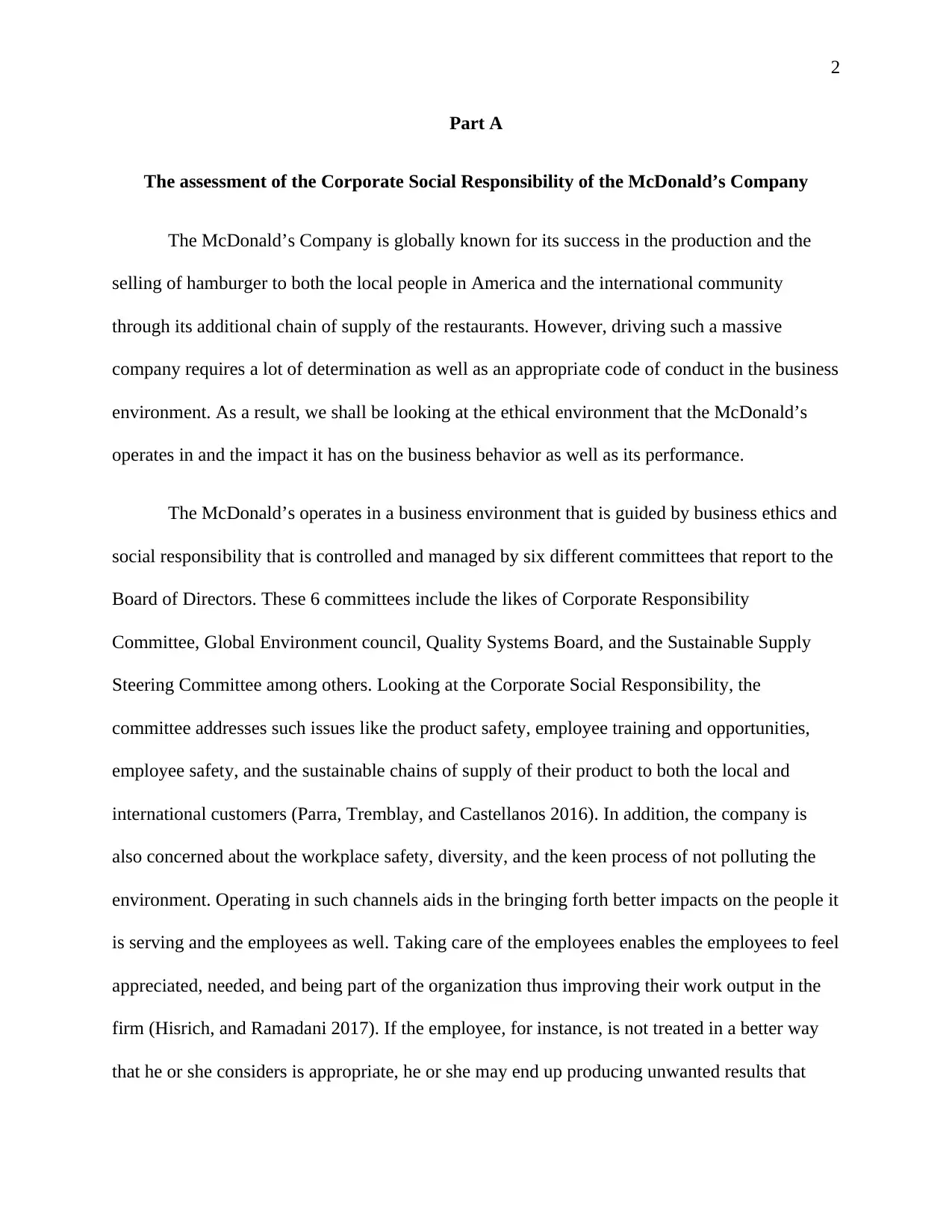
2
Part A
The assessment of the Corporate Social Responsibility of the McDonald’s Company
The McDonald’s Company is globally known for its success in the production and the
selling of hamburger to both the local people in America and the international community
through its additional chain of supply of the restaurants. However, driving such a massive
company requires a lot of determination as well as an appropriate code of conduct in the business
environment. As a result, we shall be looking at the ethical environment that the McDonald’s
operates in and the impact it has on the business behavior as well as its performance.
The McDonald’s operates in a business environment that is guided by business ethics and
social responsibility that is controlled and managed by six different committees that report to the
Board of Directors. These 6 committees include the likes of Corporate Responsibility
Committee, Global Environment council, Quality Systems Board, and the Sustainable Supply
Steering Committee among others. Looking at the Corporate Social Responsibility, the
committee addresses such issues like the product safety, employee training and opportunities,
employee safety, and the sustainable chains of supply of their product to both the local and
international customers (Parra, Tremblay, and Castellanos 2016). In addition, the company is
also concerned about the workplace safety, diversity, and the keen process of not polluting the
environment. Operating in such channels aids in the bringing forth better impacts on the people it
is serving and the employees as well. Taking care of the employees enables the employees to feel
appreciated, needed, and being part of the organization thus improving their work output in the
firm (Hisrich, and Ramadani 2017). If the employee, for instance, is not treated in a better way
that he or she considers is appropriate, he or she may end up producing unwanted results that
Part A
The assessment of the Corporate Social Responsibility of the McDonald’s Company
The McDonald’s Company is globally known for its success in the production and the
selling of hamburger to both the local people in America and the international community
through its additional chain of supply of the restaurants. However, driving such a massive
company requires a lot of determination as well as an appropriate code of conduct in the business
environment. As a result, we shall be looking at the ethical environment that the McDonald’s
operates in and the impact it has on the business behavior as well as its performance.
The McDonald’s operates in a business environment that is guided by business ethics and
social responsibility that is controlled and managed by six different committees that report to the
Board of Directors. These 6 committees include the likes of Corporate Responsibility
Committee, Global Environment council, Quality Systems Board, and the Sustainable Supply
Steering Committee among others. Looking at the Corporate Social Responsibility, the
committee addresses such issues like the product safety, employee training and opportunities,
employee safety, and the sustainable chains of supply of their product to both the local and
international customers (Parra, Tremblay, and Castellanos 2016). In addition, the company is
also concerned about the workplace safety, diversity, and the keen process of not polluting the
environment. Operating in such channels aids in the bringing forth better impacts on the people it
is serving and the employees as well. Taking care of the employees enables the employees to feel
appreciated, needed, and being part of the organization thus improving their work output in the
firm (Hisrich, and Ramadani 2017). If the employee, for instance, is not treated in a better way
that he or she considers is appropriate, he or she may end up producing unwanted results that
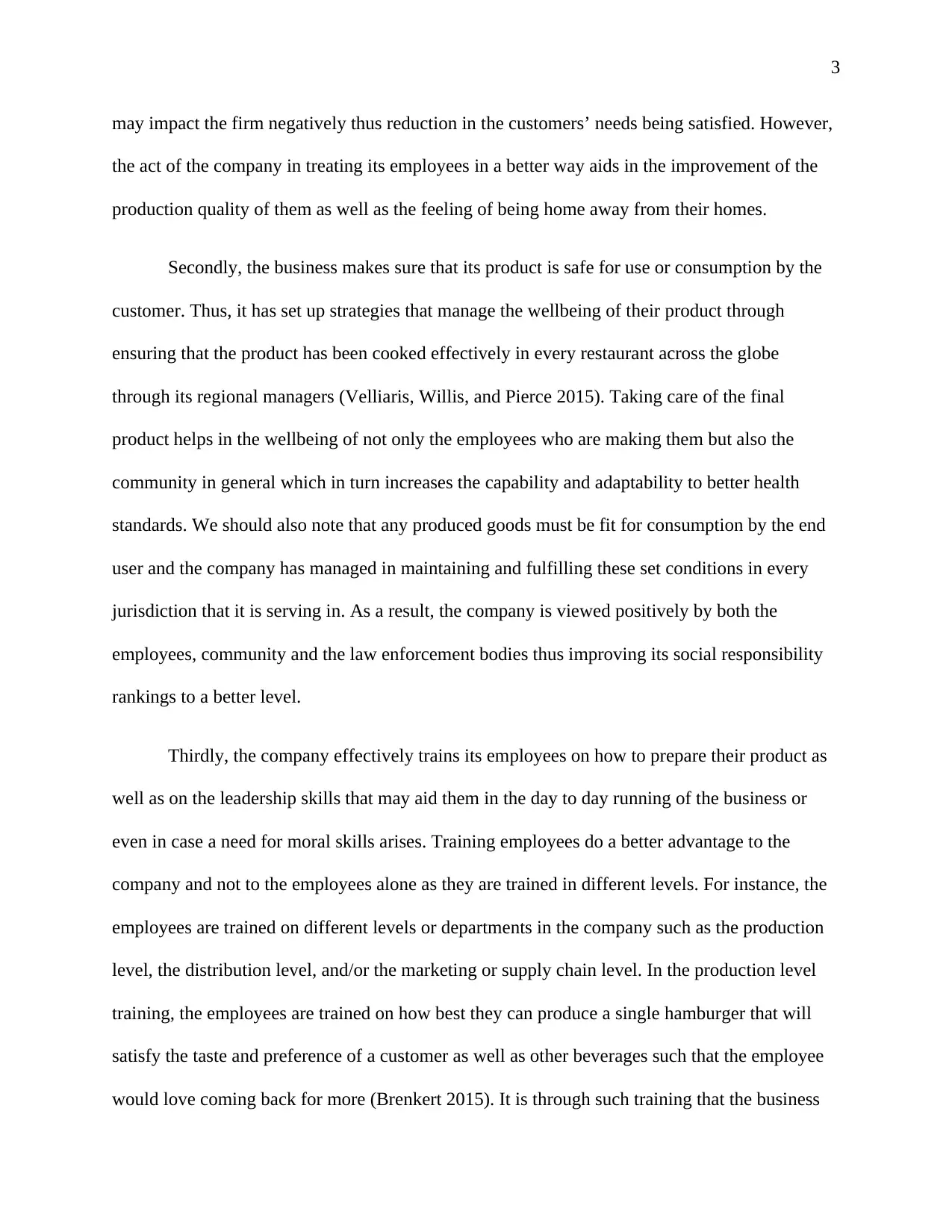
3
may impact the firm negatively thus reduction in the customers’ needs being satisfied. However,
the act of the company in treating its employees in a better way aids in the improvement of the
production quality of them as well as the feeling of being home away from their homes.
Secondly, the business makes sure that its product is safe for use or consumption by the
customer. Thus, it has set up strategies that manage the wellbeing of their product through
ensuring that the product has been cooked effectively in every restaurant across the globe
through its regional managers (Velliaris, Willis, and Pierce 2015). Taking care of the final
product helps in the wellbeing of not only the employees who are making them but also the
community in general which in turn increases the capability and adaptability to better health
standards. We should also note that any produced goods must be fit for consumption by the end
user and the company has managed in maintaining and fulfilling these set conditions in every
jurisdiction that it is serving in. As a result, the company is viewed positively by both the
employees, community and the law enforcement bodies thus improving its social responsibility
rankings to a better level.
Thirdly, the company effectively trains its employees on how to prepare their product as
well as on the leadership skills that may aid them in the day to day running of the business or
even in case a need for moral skills arises. Training employees do a better advantage to the
company and not to the employees alone as they are trained in different levels. For instance, the
employees are trained on different levels or departments in the company such as the production
level, the distribution level, and/or the marketing or supply chain level. In the production level
training, the employees are trained on how best they can produce a single hamburger that will
satisfy the taste and preference of a customer as well as other beverages such that the employee
would love coming back for more (Brenkert 2015). It is through such training that the business
may impact the firm negatively thus reduction in the customers’ needs being satisfied. However,
the act of the company in treating its employees in a better way aids in the improvement of the
production quality of them as well as the feeling of being home away from their homes.
Secondly, the business makes sure that its product is safe for use or consumption by the
customer. Thus, it has set up strategies that manage the wellbeing of their product through
ensuring that the product has been cooked effectively in every restaurant across the globe
through its regional managers (Velliaris, Willis, and Pierce 2015). Taking care of the final
product helps in the wellbeing of not only the employees who are making them but also the
community in general which in turn increases the capability and adaptability to better health
standards. We should also note that any produced goods must be fit for consumption by the end
user and the company has managed in maintaining and fulfilling these set conditions in every
jurisdiction that it is serving in. As a result, the company is viewed positively by both the
employees, community and the law enforcement bodies thus improving its social responsibility
rankings to a better level.
Thirdly, the company effectively trains its employees on how to prepare their product as
well as on the leadership skills that may aid them in the day to day running of the business or
even in case a need for moral skills arises. Training employees do a better advantage to the
company and not to the employees alone as they are trained in different levels. For instance, the
employees are trained on different levels or departments in the company such as the production
level, the distribution level, and/or the marketing or supply chain level. In the production level
training, the employees are trained on how best they can produce a single hamburger that will
satisfy the taste and preference of a customer as well as other beverages such that the employee
would love coming back for more (Brenkert 2015). It is through such training that the business
⊘ This is a preview!⊘
Do you want full access?
Subscribe today to unlock all pages.

Trusted by 1+ million students worldwide
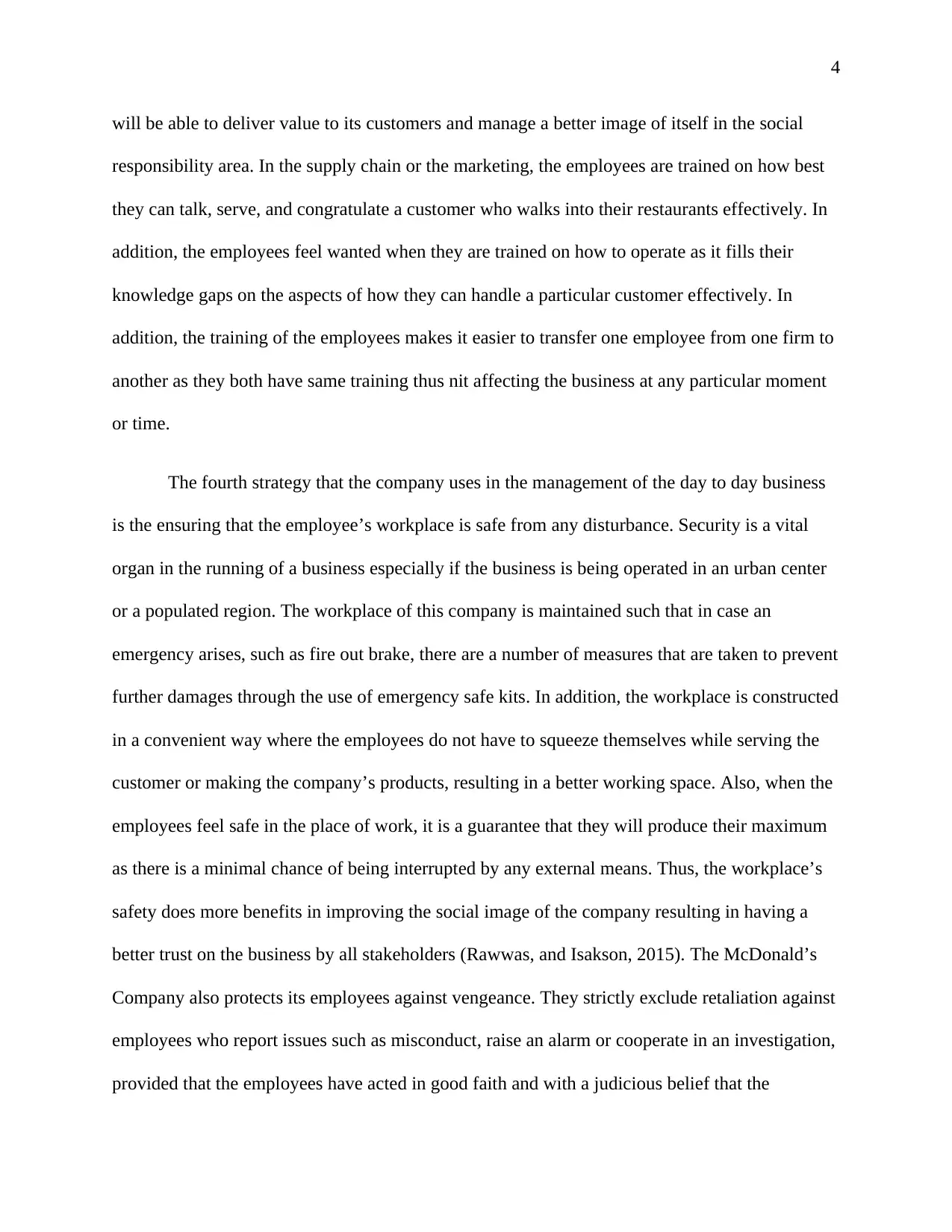
4
will be able to deliver value to its customers and manage a better image of itself in the social
responsibility area. In the supply chain or the marketing, the employees are trained on how best
they can talk, serve, and congratulate a customer who walks into their restaurants effectively. In
addition, the employees feel wanted when they are trained on how to operate as it fills their
knowledge gaps on the aspects of how they can handle a particular customer effectively. In
addition, the training of the employees makes it easier to transfer one employee from one firm to
another as they both have same training thus nit affecting the business at any particular moment
or time.
The fourth strategy that the company uses in the management of the day to day business
is the ensuring that the employee’s workplace is safe from any disturbance. Security is a vital
organ in the running of a business especially if the business is being operated in an urban center
or a populated region. The workplace of this company is maintained such that in case an
emergency arises, such as fire out brake, there are a number of measures that are taken to prevent
further damages through the use of emergency safe kits. In addition, the workplace is constructed
in a convenient way where the employees do not have to squeeze themselves while serving the
customer or making the company’s products, resulting in a better working space. Also, when the
employees feel safe in the place of work, it is a guarantee that they will produce their maximum
as there is a minimal chance of being interrupted by any external means. Thus, the workplace’s
safety does more benefits in improving the social image of the company resulting in having a
better trust on the business by all stakeholders (Rawwas, and Isakson, 2015). The McDonald’s
Company also protects its employees against vengeance. They strictly exclude retaliation against
employees who report issues such as misconduct, raise an alarm or cooperate in an investigation,
provided that the employees have acted in good faith and with a judicious belief that the
will be able to deliver value to its customers and manage a better image of itself in the social
responsibility area. In the supply chain or the marketing, the employees are trained on how best
they can talk, serve, and congratulate a customer who walks into their restaurants effectively. In
addition, the employees feel wanted when they are trained on how to operate as it fills their
knowledge gaps on the aspects of how they can handle a particular customer effectively. In
addition, the training of the employees makes it easier to transfer one employee from one firm to
another as they both have same training thus nit affecting the business at any particular moment
or time.
The fourth strategy that the company uses in the management of the day to day business
is the ensuring that the employee’s workplace is safe from any disturbance. Security is a vital
organ in the running of a business especially if the business is being operated in an urban center
or a populated region. The workplace of this company is maintained such that in case an
emergency arises, such as fire out brake, there are a number of measures that are taken to prevent
further damages through the use of emergency safe kits. In addition, the workplace is constructed
in a convenient way where the employees do not have to squeeze themselves while serving the
customer or making the company’s products, resulting in a better working space. Also, when the
employees feel safe in the place of work, it is a guarantee that they will produce their maximum
as there is a minimal chance of being interrupted by any external means. Thus, the workplace’s
safety does more benefits in improving the social image of the company resulting in having a
better trust on the business by all stakeholders (Rawwas, and Isakson, 2015). The McDonald’s
Company also protects its employees against vengeance. They strictly exclude retaliation against
employees who report issues such as misconduct, raise an alarm or cooperate in an investigation,
provided that the employees have acted in good faith and with a judicious belief that the
Paraphrase This Document
Need a fresh take? Get an instant paraphrase of this document with our AI Paraphraser
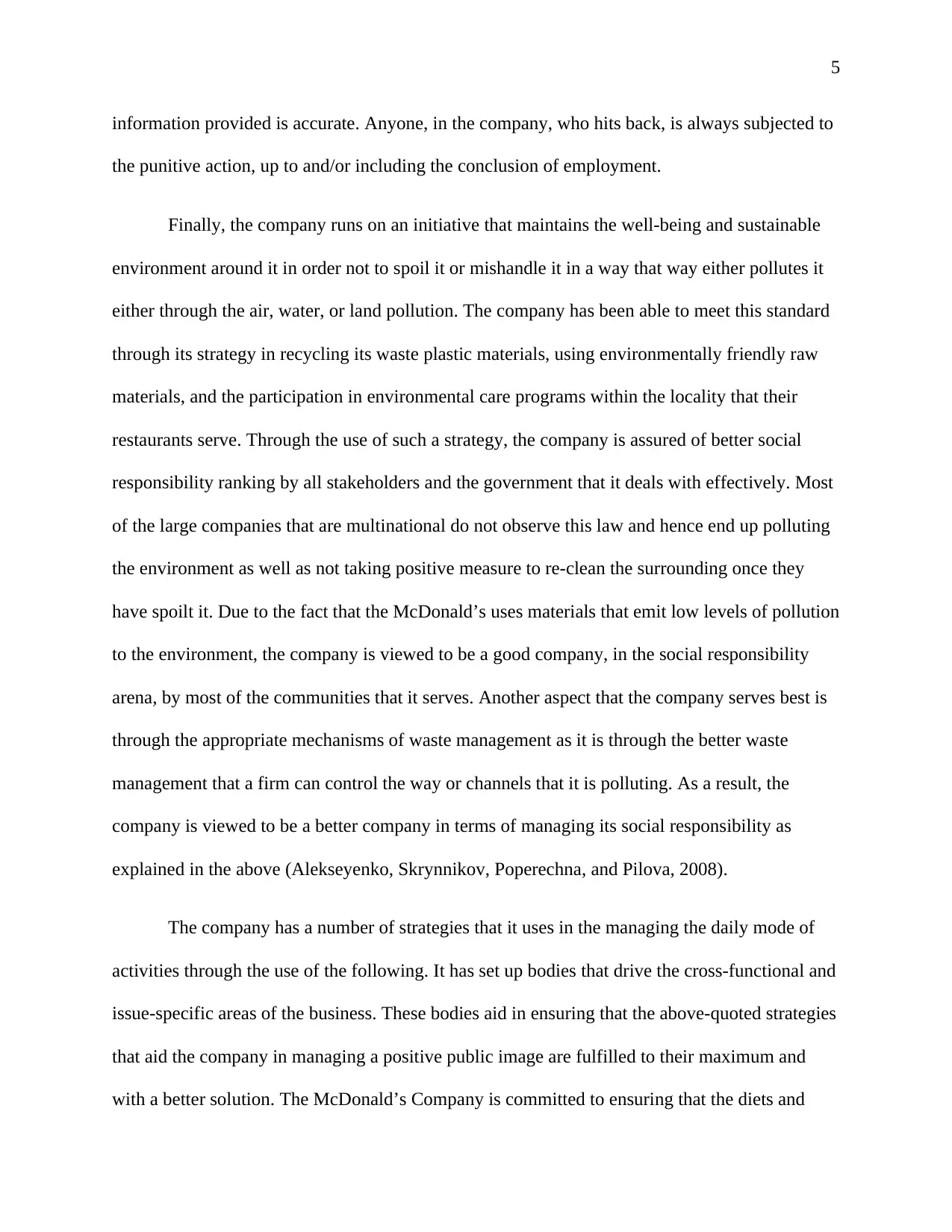
5
information provided is accurate. Anyone, in the company, who hits back, is always subjected to
the punitive action, up to and/or including the conclusion of employment.
Finally, the company runs on an initiative that maintains the well-being and sustainable
environment around it in order not to spoil it or mishandle it in a way that way either pollutes it
either through the air, water, or land pollution. The company has been able to meet this standard
through its strategy in recycling its waste plastic materials, using environmentally friendly raw
materials, and the participation in environmental care programs within the locality that their
restaurants serve. Through the use of such a strategy, the company is assured of better social
responsibility ranking by all stakeholders and the government that it deals with effectively. Most
of the large companies that are multinational do not observe this law and hence end up polluting
the environment as well as not taking positive measure to re-clean the surrounding once they
have spoilt it. Due to the fact that the McDonald’s uses materials that emit low levels of pollution
to the environment, the company is viewed to be a good company, in the social responsibility
arena, by most of the communities that it serves. Another aspect that the company serves best is
through the appropriate mechanisms of waste management as it is through the better waste
management that a firm can control the way or channels that it is polluting. As a result, the
company is viewed to be a better company in terms of managing its social responsibility as
explained in the above (Alekseyenko, Skrynnikov, Poperechna, and Pilova, 2008).
The company has a number of strategies that it uses in the managing the daily mode of
activities through the use of the following. It has set up bodies that drive the cross-functional and
issue-specific areas of the business. These bodies aid in ensuring that the above-quoted strategies
that aid the company in managing a positive public image are fulfilled to their maximum and
with a better solution. The McDonald’s Company is committed to ensuring that the diets and
information provided is accurate. Anyone, in the company, who hits back, is always subjected to
the punitive action, up to and/or including the conclusion of employment.
Finally, the company runs on an initiative that maintains the well-being and sustainable
environment around it in order not to spoil it or mishandle it in a way that way either pollutes it
either through the air, water, or land pollution. The company has been able to meet this standard
through its strategy in recycling its waste plastic materials, using environmentally friendly raw
materials, and the participation in environmental care programs within the locality that their
restaurants serve. Through the use of such a strategy, the company is assured of better social
responsibility ranking by all stakeholders and the government that it deals with effectively. Most
of the large companies that are multinational do not observe this law and hence end up polluting
the environment as well as not taking positive measure to re-clean the surrounding once they
have spoilt it. Due to the fact that the McDonald’s uses materials that emit low levels of pollution
to the environment, the company is viewed to be a good company, in the social responsibility
arena, by most of the communities that it serves. Another aspect that the company serves best is
through the appropriate mechanisms of waste management as it is through the better waste
management that a firm can control the way or channels that it is polluting. As a result, the
company is viewed to be a better company in terms of managing its social responsibility as
explained in the above (Alekseyenko, Skrynnikov, Poperechna, and Pilova, 2008).
The company has a number of strategies that it uses in the managing the daily mode of
activities through the use of the following. It has set up bodies that drive the cross-functional and
issue-specific areas of the business. These bodies aid in ensuring that the above-quoted strategies
that aid the company in managing a positive public image are fulfilled to their maximum and
with a better solution. The McDonald’s Company is committed to ensuring that the diets and
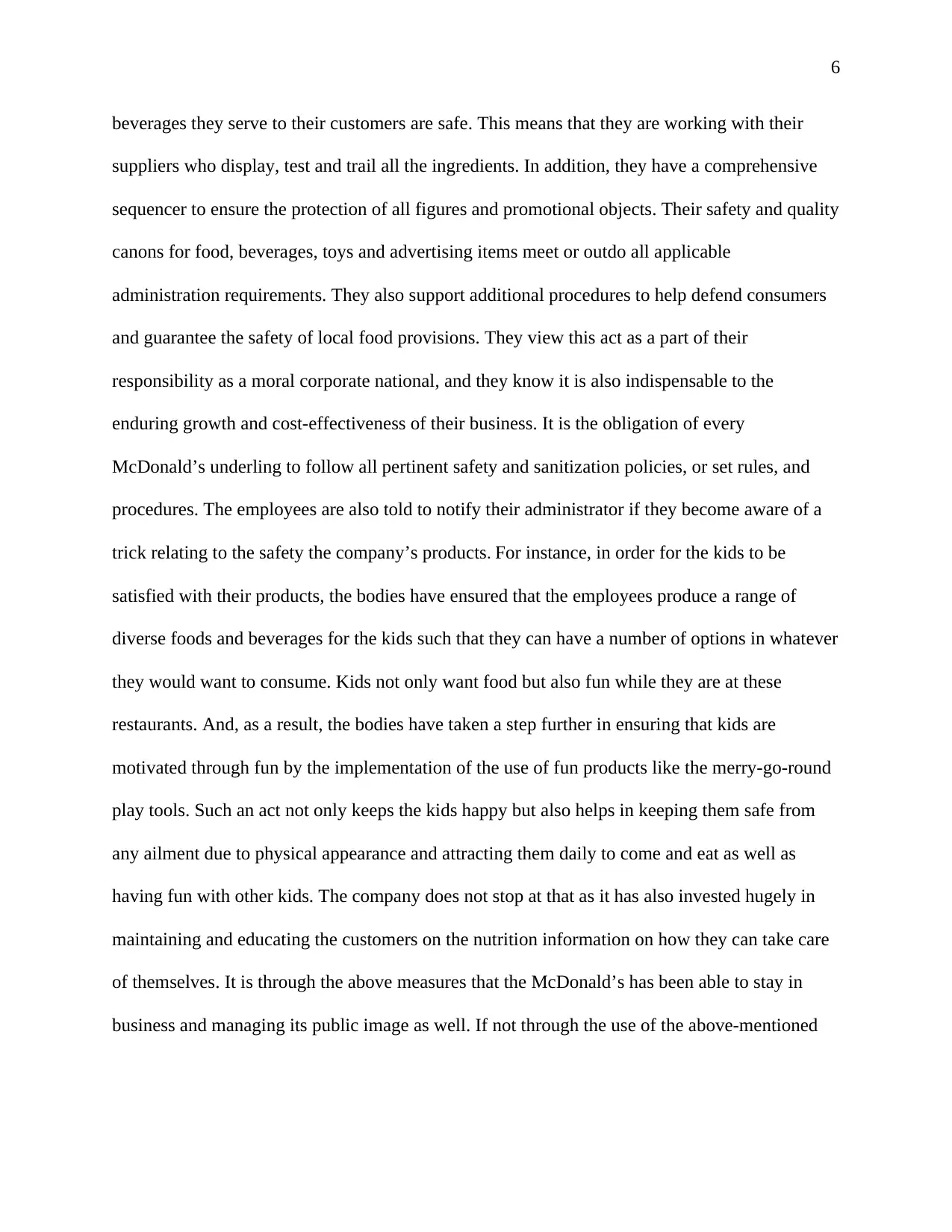
6
beverages they serve to their customers are safe. This means that they are working with their
suppliers who display, test and trail all the ingredients. In addition, they have a comprehensive
sequencer to ensure the protection of all figures and promotional objects. Their safety and quality
canons for food, beverages, toys and advertising items meet or outdo all applicable
administration requirements. They also support additional procedures to help defend consumers
and guarantee the safety of local food provisions. They view this act as a part of their
responsibility as a moral corporate national, and they know it is also indispensable to the
enduring growth and cost-effectiveness of their business. It is the obligation of every
McDonald’s underling to follow all pertinent safety and sanitization policies, or set rules, and
procedures. The employees are also told to notify their administrator if they become aware of a
trick relating to the safety the company’s products. For instance, in order for the kids to be
satisfied with their products, the bodies have ensured that the employees produce a range of
diverse foods and beverages for the kids such that they can have a number of options in whatever
they would want to consume. Kids not only want food but also fun while they are at these
restaurants. And, as a result, the bodies have taken a step further in ensuring that kids are
motivated through fun by the implementation of the use of fun products like the merry-go-round
play tools. Such an act not only keeps the kids happy but also helps in keeping them safe from
any ailment due to physical appearance and attracting them daily to come and eat as well as
having fun with other kids. The company does not stop at that as it has also invested hugely in
maintaining and educating the customers on the nutrition information on how they can take care
of themselves. It is through the above measures that the McDonald’s has been able to stay in
business and managing its public image as well. If not through the use of the above-mentioned
beverages they serve to their customers are safe. This means that they are working with their
suppliers who display, test and trail all the ingredients. In addition, they have a comprehensive
sequencer to ensure the protection of all figures and promotional objects. Their safety and quality
canons for food, beverages, toys and advertising items meet or outdo all applicable
administration requirements. They also support additional procedures to help defend consumers
and guarantee the safety of local food provisions. They view this act as a part of their
responsibility as a moral corporate national, and they know it is also indispensable to the
enduring growth and cost-effectiveness of their business. It is the obligation of every
McDonald’s underling to follow all pertinent safety and sanitization policies, or set rules, and
procedures. The employees are also told to notify their administrator if they become aware of a
trick relating to the safety the company’s products. For instance, in order for the kids to be
satisfied with their products, the bodies have ensured that the employees produce a range of
diverse foods and beverages for the kids such that they can have a number of options in whatever
they would want to consume. Kids not only want food but also fun while they are at these
restaurants. And, as a result, the bodies have taken a step further in ensuring that kids are
motivated through fun by the implementation of the use of fun products like the merry-go-round
play tools. Such an act not only keeps the kids happy but also helps in keeping them safe from
any ailment due to physical appearance and attracting them daily to come and eat as well as
having fun with other kids. The company does not stop at that as it has also invested hugely in
maintaining and educating the customers on the nutrition information on how they can take care
of themselves. It is through the above measures that the McDonald’s has been able to stay in
business and managing its public image as well. If not through the use of the above-mentioned
⊘ This is a preview!⊘
Do you want full access?
Subscribe today to unlock all pages.

Trusted by 1+ million students worldwide
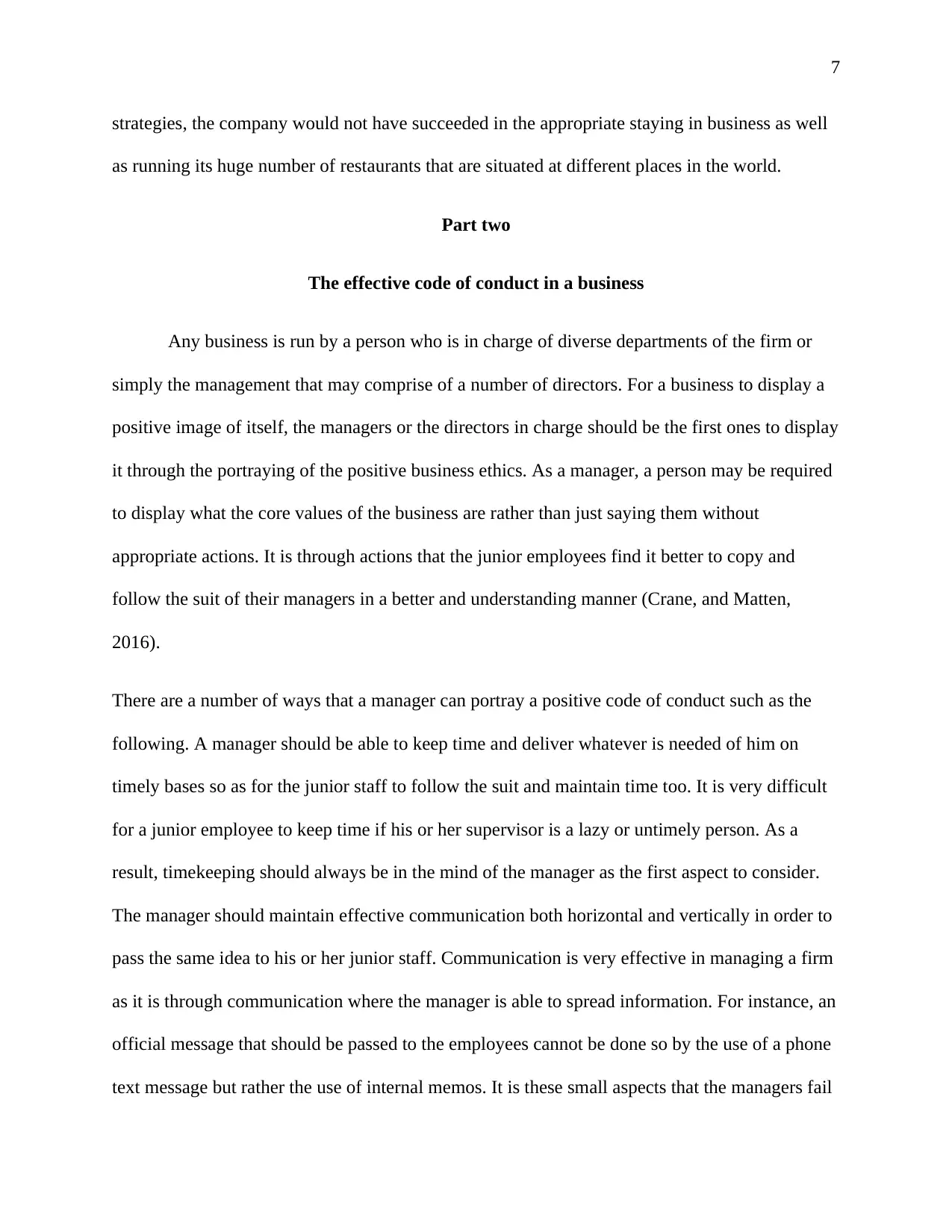
7
strategies, the company would not have succeeded in the appropriate staying in business as well
as running its huge number of restaurants that are situated at different places in the world.
Part two
The effective code of conduct in a business
Any business is run by a person who is in charge of diverse departments of the firm or
simply the management that may comprise of a number of directors. For a business to display a
positive image of itself, the managers or the directors in charge should be the first ones to display
it through the portraying of the positive business ethics. As a manager, a person may be required
to display what the core values of the business are rather than just saying them without
appropriate actions. It is through actions that the junior employees find it better to copy and
follow the suit of their managers in a better and understanding manner (Crane, and Matten,
2016).
There are a number of ways that a manager can portray a positive code of conduct such as the
following. A manager should be able to keep time and deliver whatever is needed of him on
timely bases so as for the junior staff to follow the suit and maintain time too. It is very difficult
for a junior employee to keep time if his or her supervisor is a lazy or untimely person. As a
result, timekeeping should always be in the mind of the manager as the first aspect to consider.
The manager should maintain effective communication both horizontal and vertically in order to
pass the same idea to his or her junior staff. Communication is very effective in managing a firm
as it is through communication where the manager is able to spread information. For instance, an
official message that should be passed to the employees cannot be done so by the use of a phone
text message but rather the use of internal memos. It is these small aspects that the managers fail
strategies, the company would not have succeeded in the appropriate staying in business as well
as running its huge number of restaurants that are situated at different places in the world.
Part two
The effective code of conduct in a business
Any business is run by a person who is in charge of diverse departments of the firm or
simply the management that may comprise of a number of directors. For a business to display a
positive image of itself, the managers or the directors in charge should be the first ones to display
it through the portraying of the positive business ethics. As a manager, a person may be required
to display what the core values of the business are rather than just saying them without
appropriate actions. It is through actions that the junior employees find it better to copy and
follow the suit of their managers in a better and understanding manner (Crane, and Matten,
2016).
There are a number of ways that a manager can portray a positive code of conduct such as the
following. A manager should be able to keep time and deliver whatever is needed of him on
timely bases so as for the junior staff to follow the suit and maintain time too. It is very difficult
for a junior employee to keep time if his or her supervisor is a lazy or untimely person. As a
result, timekeeping should always be in the mind of the manager as the first aspect to consider.
The manager should maintain effective communication both horizontal and vertically in order to
pass the same idea to his or her junior staff. Communication is very effective in managing a firm
as it is through communication where the manager is able to spread information. For instance, an
official message that should be passed to the employees cannot be done so by the use of a phone
text message but rather the use of internal memos. It is these small aspects that the managers fail
Paraphrase This Document
Need a fresh take? Get an instant paraphrase of this document with our AI Paraphraser
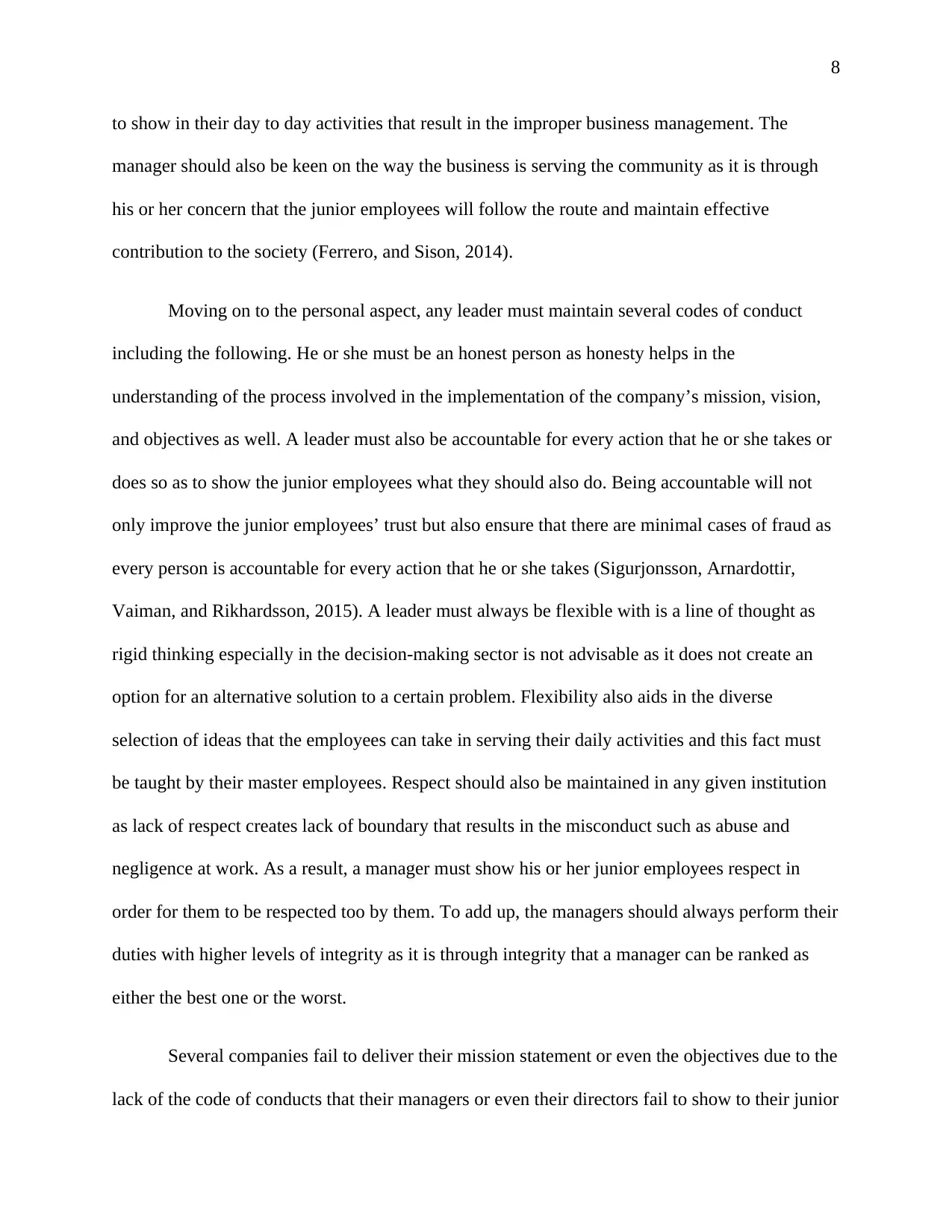
8
to show in their day to day activities that result in the improper business management. The
manager should also be keen on the way the business is serving the community as it is through
his or her concern that the junior employees will follow the route and maintain effective
contribution to the society (Ferrero, and Sison, 2014).
Moving on to the personal aspect, any leader must maintain several codes of conduct
including the following. He or she must be an honest person as honesty helps in the
understanding of the process involved in the implementation of the company’s mission, vision,
and objectives as well. A leader must also be accountable for every action that he or she takes or
does so as to show the junior employees what they should also do. Being accountable will not
only improve the junior employees’ trust but also ensure that there are minimal cases of fraud as
every person is accountable for every action that he or she takes (Sigurjonsson, Arnardottir,
Vaiman, and Rikhardsson, 2015). A leader must always be flexible with is a line of thought as
rigid thinking especially in the decision-making sector is not advisable as it does not create an
option for an alternative solution to a certain problem. Flexibility also aids in the diverse
selection of ideas that the employees can take in serving their daily activities and this fact must
be taught by their master employees. Respect should also be maintained in any given institution
as lack of respect creates lack of boundary that results in the misconduct such as abuse and
negligence at work. As a result, a manager must show his or her junior employees respect in
order for them to be respected too by them. To add up, the managers should always perform their
duties with higher levels of integrity as it is through integrity that a manager can be ranked as
either the best one or the worst.
Several companies fail to deliver their mission statement or even the objectives due to the
lack of the code of conducts that their managers or even their directors fail to show to their junior
to show in their day to day activities that result in the improper business management. The
manager should also be keen on the way the business is serving the community as it is through
his or her concern that the junior employees will follow the route and maintain effective
contribution to the society (Ferrero, and Sison, 2014).
Moving on to the personal aspect, any leader must maintain several codes of conduct
including the following. He or she must be an honest person as honesty helps in the
understanding of the process involved in the implementation of the company’s mission, vision,
and objectives as well. A leader must also be accountable for every action that he or she takes or
does so as to show the junior employees what they should also do. Being accountable will not
only improve the junior employees’ trust but also ensure that there are minimal cases of fraud as
every person is accountable for every action that he or she takes (Sigurjonsson, Arnardottir,
Vaiman, and Rikhardsson, 2015). A leader must always be flexible with is a line of thought as
rigid thinking especially in the decision-making sector is not advisable as it does not create an
option for an alternative solution to a certain problem. Flexibility also aids in the diverse
selection of ideas that the employees can take in serving their daily activities and this fact must
be taught by their master employees. Respect should also be maintained in any given institution
as lack of respect creates lack of boundary that results in the misconduct such as abuse and
negligence at work. As a result, a manager must show his or her junior employees respect in
order for them to be respected too by them. To add up, the managers should always perform their
duties with higher levels of integrity as it is through integrity that a manager can be ranked as
either the best one or the worst.
Several companies fail to deliver their mission statement or even the objectives due to the
lack of the code of conducts that their managers or even their directors fail to show to their junior
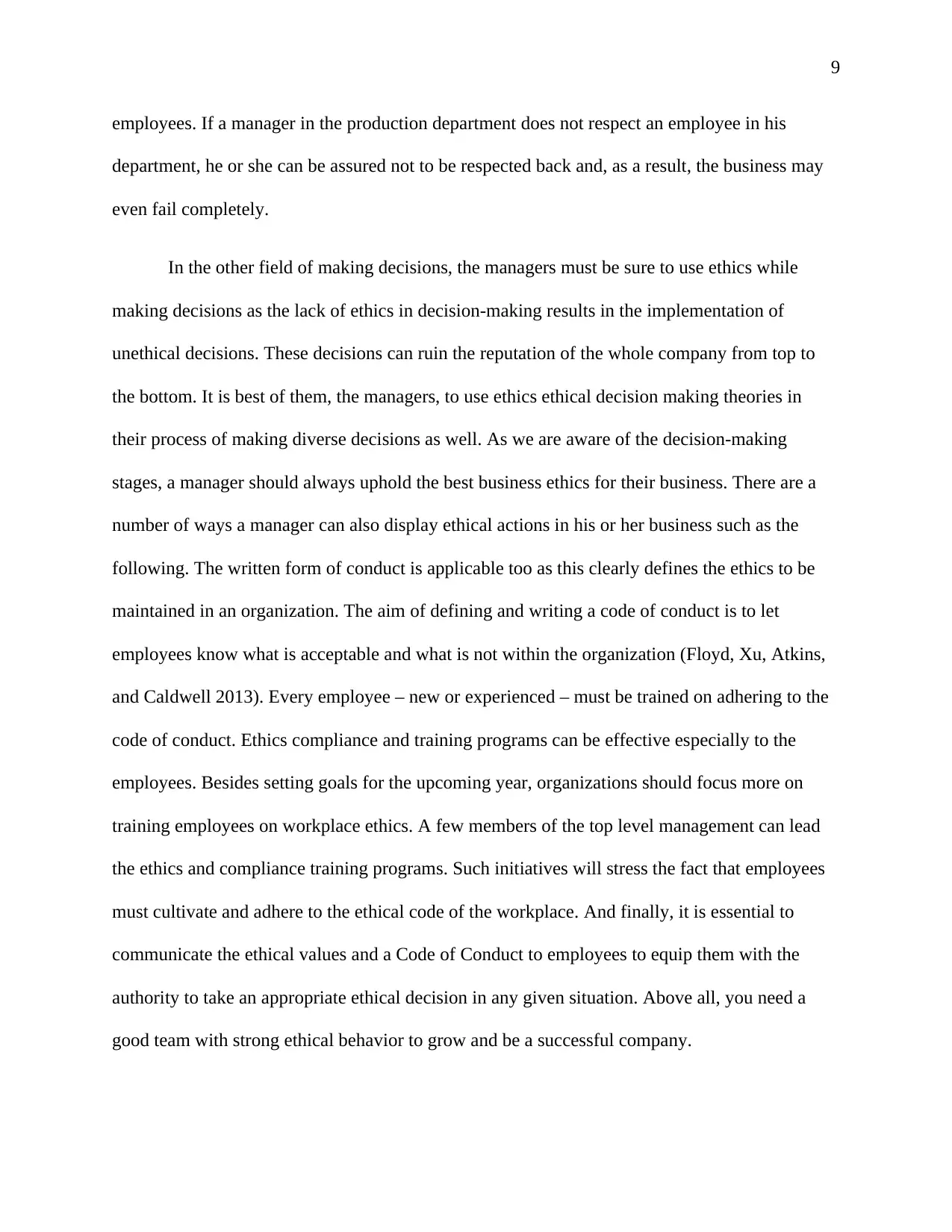
9
employees. If a manager in the production department does not respect an employee in his
department, he or she can be assured not to be respected back and, as a result, the business may
even fail completely.
In the other field of making decisions, the managers must be sure to use ethics while
making decisions as the lack of ethics in decision-making results in the implementation of
unethical decisions. These decisions can ruin the reputation of the whole company from top to
the bottom. It is best of them, the managers, to use ethics ethical decision making theories in
their process of making diverse decisions as well. As we are aware of the decision-making
stages, a manager should always uphold the best business ethics for their business. There are a
number of ways a manager can also display ethical actions in his or her business such as the
following. The written form of conduct is applicable too as this clearly defines the ethics to be
maintained in an organization. The aim of defining and writing a code of conduct is to let
employees know what is acceptable and what is not within the organization (Floyd, Xu, Atkins,
and Caldwell 2013). Every employee – new or experienced – must be trained on adhering to the
code of conduct. Ethics compliance and training programs can be effective especially to the
employees. Besides setting goals for the upcoming year, organizations should focus more on
training employees on workplace ethics. A few members of the top level management can lead
the ethics and compliance training programs. Such initiatives will stress the fact that employees
must cultivate and adhere to the ethical code of the workplace. And finally, it is essential to
communicate the ethical values and a Code of Conduct to employees to equip them with the
authority to take an appropriate ethical decision in any given situation. Above all, you need a
good team with strong ethical behavior to grow and be a successful company.
employees. If a manager in the production department does not respect an employee in his
department, he or she can be assured not to be respected back and, as a result, the business may
even fail completely.
In the other field of making decisions, the managers must be sure to use ethics while
making decisions as the lack of ethics in decision-making results in the implementation of
unethical decisions. These decisions can ruin the reputation of the whole company from top to
the bottom. It is best of them, the managers, to use ethics ethical decision making theories in
their process of making diverse decisions as well. As we are aware of the decision-making
stages, a manager should always uphold the best business ethics for their business. There are a
number of ways a manager can also display ethical actions in his or her business such as the
following. The written form of conduct is applicable too as this clearly defines the ethics to be
maintained in an organization. The aim of defining and writing a code of conduct is to let
employees know what is acceptable and what is not within the organization (Floyd, Xu, Atkins,
and Caldwell 2013). Every employee – new or experienced – must be trained on adhering to the
code of conduct. Ethics compliance and training programs can be effective especially to the
employees. Besides setting goals for the upcoming year, organizations should focus more on
training employees on workplace ethics. A few members of the top level management can lead
the ethics and compliance training programs. Such initiatives will stress the fact that employees
must cultivate and adhere to the ethical code of the workplace. And finally, it is essential to
communicate the ethical values and a Code of Conduct to employees to equip them with the
authority to take an appropriate ethical decision in any given situation. Above all, you need a
good team with strong ethical behavior to grow and be a successful company.
⊘ This is a preview!⊘
Do you want full access?
Subscribe today to unlock all pages.

Trusted by 1+ million students worldwide
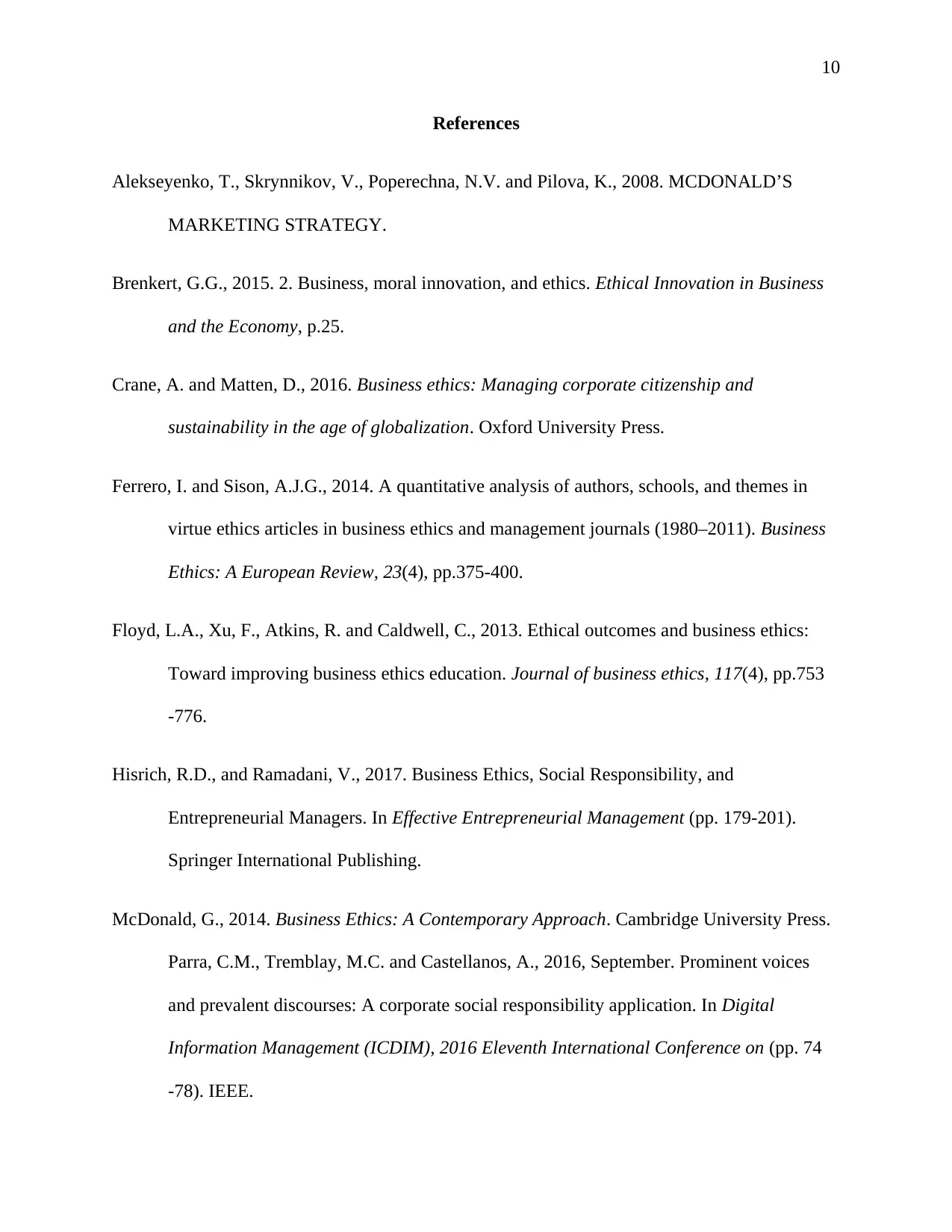
10
References
Alekseyenko, T., Skrynnikov, V., Poperechna, N.V. and Pilova, K., 2008. MCDONALD’S
MARKETING STRATEGY.
Brenkert, G.G., 2015. 2. Business, moral innovation, and ethics. Ethical Innovation in Business
and the Economy, p.25.
Crane, A. and Matten, D., 2016. Business ethics: Managing corporate citizenship and
sustainability in the age of globalization. Oxford University Press.
Ferrero, I. and Sison, A.J.G., 2014. A quantitative analysis of authors, schools, and themes in
virtue ethics articles in business ethics and management journals (1980–2011). Business
Ethics: A European Review, 23(4), pp.375-400.
Floyd, L.A., Xu, F., Atkins, R. and Caldwell, C., 2013. Ethical outcomes and business ethics:
Toward improving business ethics education. Journal of business ethics, 117(4), pp.753
-776.
Hisrich, R.D., and Ramadani, V., 2017. Business Ethics, Social Responsibility, and
Entrepreneurial Managers. In Effective Entrepreneurial Management (pp. 179-201).
Springer International Publishing.
McDonald, G., 2014. Business Ethics: A Contemporary Approach. Cambridge University Press.
Parra, C.M., Tremblay, M.C. and Castellanos, A., 2016, September. Prominent voices
and prevalent discourses: A corporate social responsibility application. In Digital
Information Management (ICDIM), 2016 Eleventh International Conference on (pp. 74
-78). IEEE.
References
Alekseyenko, T., Skrynnikov, V., Poperechna, N.V. and Pilova, K., 2008. MCDONALD’S
MARKETING STRATEGY.
Brenkert, G.G., 2015. 2. Business, moral innovation, and ethics. Ethical Innovation in Business
and the Economy, p.25.
Crane, A. and Matten, D., 2016. Business ethics: Managing corporate citizenship and
sustainability in the age of globalization. Oxford University Press.
Ferrero, I. and Sison, A.J.G., 2014. A quantitative analysis of authors, schools, and themes in
virtue ethics articles in business ethics and management journals (1980–2011). Business
Ethics: A European Review, 23(4), pp.375-400.
Floyd, L.A., Xu, F., Atkins, R. and Caldwell, C., 2013. Ethical outcomes and business ethics:
Toward improving business ethics education. Journal of business ethics, 117(4), pp.753
-776.
Hisrich, R.D., and Ramadani, V., 2017. Business Ethics, Social Responsibility, and
Entrepreneurial Managers. In Effective Entrepreneurial Management (pp. 179-201).
Springer International Publishing.
McDonald, G., 2014. Business Ethics: A Contemporary Approach. Cambridge University Press.
Parra, C.M., Tremblay, M.C. and Castellanos, A., 2016, September. Prominent voices
and prevalent discourses: A corporate social responsibility application. In Digital
Information Management (ICDIM), 2016 Eleventh International Conference on (pp. 74
-78). IEEE.
Paraphrase This Document
Need a fresh take? Get an instant paraphrase of this document with our AI Paraphraser
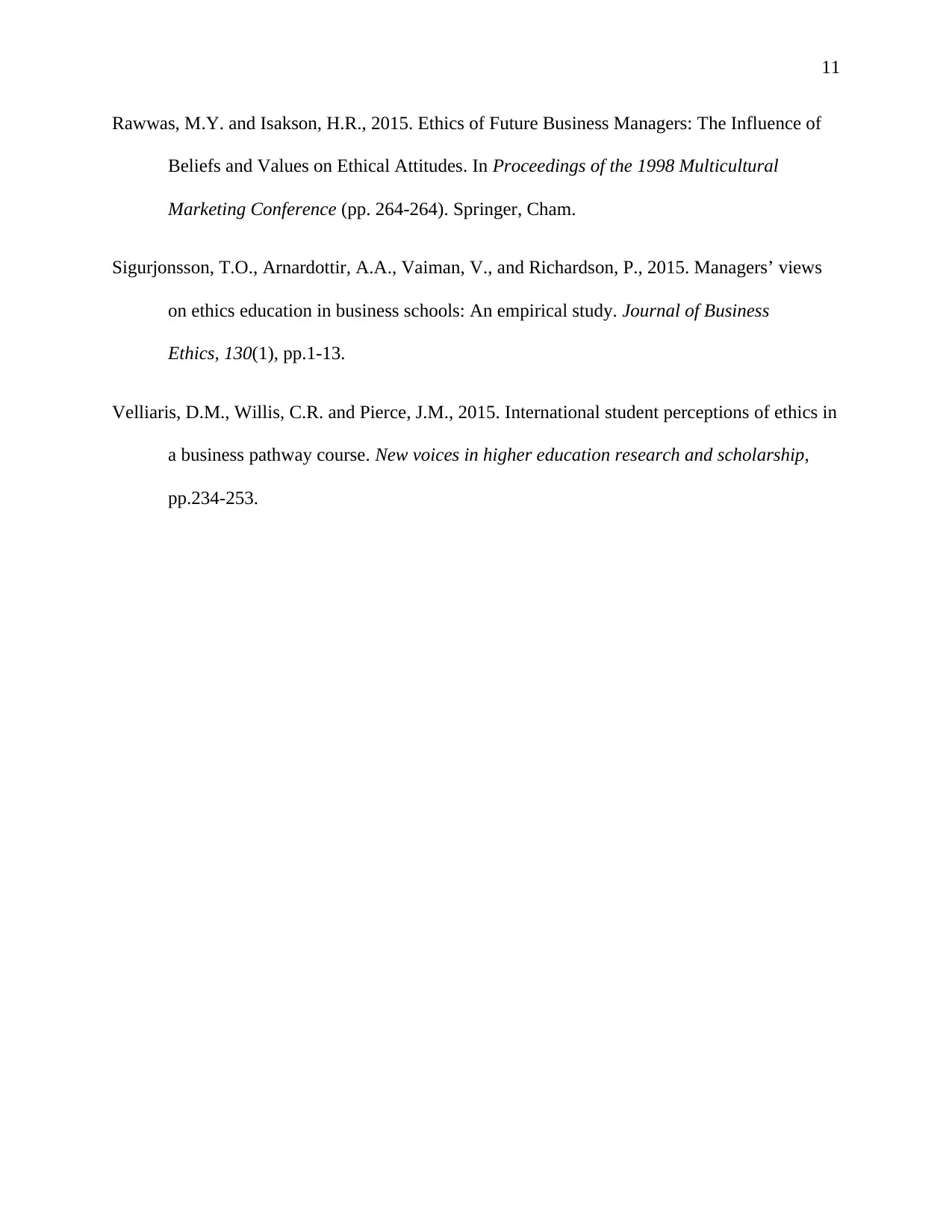
11
Rawwas, M.Y. and Isakson, H.R., 2015. Ethics of Future Business Managers: The Influence of
Beliefs and Values on Ethical Attitudes. In Proceedings of the 1998 Multicultural
Marketing Conference (pp. 264-264). Springer, Cham.
Sigurjonsson, T.O., Arnardottir, A.A., Vaiman, V., and Richardson, P., 2015. Managers’ views
on ethics education in business schools: An empirical study. Journal of Business
Ethics, 130(1), pp.1-13.
Velliaris, D.M., Willis, C.R. and Pierce, J.M., 2015. International student perceptions of ethics in
a business pathway course. New voices in higher education research and scholarship,
pp.234-253.
Rawwas, M.Y. and Isakson, H.R., 2015. Ethics of Future Business Managers: The Influence of
Beliefs and Values on Ethical Attitudes. In Proceedings of the 1998 Multicultural
Marketing Conference (pp. 264-264). Springer, Cham.
Sigurjonsson, T.O., Arnardottir, A.A., Vaiman, V., and Richardson, P., 2015. Managers’ views
on ethics education in business schools: An empirical study. Journal of Business
Ethics, 130(1), pp.1-13.
Velliaris, D.M., Willis, C.R. and Pierce, J.M., 2015. International student perceptions of ethics in
a business pathway course. New voices in higher education research and scholarship,
pp.234-253.
1 out of 11
Related Documents
Your All-in-One AI-Powered Toolkit for Academic Success.
+13062052269
info@desklib.com
Available 24*7 on WhatsApp / Email
![[object Object]](/_next/static/media/star-bottom.7253800d.svg)
Unlock your academic potential
Copyright © 2020–2025 A2Z Services. All Rights Reserved. Developed and managed by ZUCOL.





